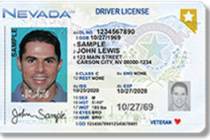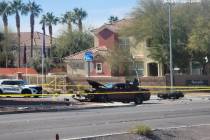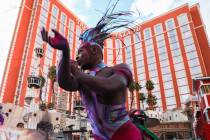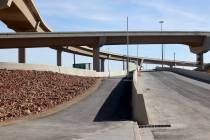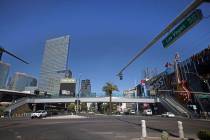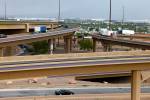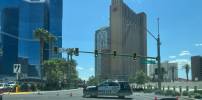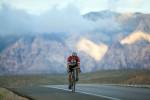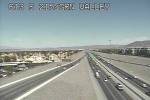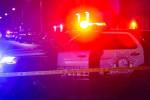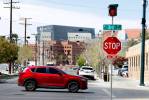Many factors lead to I-15 accidents at Sahara
Whenever we receive an accident alert from the Regional Transportation Commission, someone in the newsroom blurts out, "Let me guess, I-15 at Sahara." It's about as bold a proclamation as saying Las Vegas summers are hot.
Whenever Nevada Highway Patrol Trooper Loy Hixson speaks at a gathering and mentions Interstate 15 and Sahara, he hears grumbles and a few incredulous chuckles.
Troopers respond to an average of 15 accidents during a 24-hour period on northbound I-15 around Sahara Avenue. That is in part why Hixson and his fellow officers now carry brooms and sand in their patrol cars, but we'll get to that in a minute.
Even casual readers are aware of the mysterious crash zone that plagues Interstate 15 between Sahara and Charleston Boulevard.
"I receive traffic alerts from the RTC, and for years I have noticed that the majority of the accidents that they report happen from south of Sahara to north of Charleston," a reader recently wrote. "This is obviously a very dangerous couple of miles."
Bingo. But to convince a transportation official to comment on the problem is no easy task.
Two years ago, we conducted our own informal study on that stretch of freeway and found that 38 percent of 140 freeway accidents listed in the RTC's alerts occurred on Interstate 15 at or near Sahara.
Of those collisions, 87 percent happened on northbound I-15.
At the time, the Nevada Department of Transportation blamed the new exit-only lane at Sahara and said motorists at the last second tried to merge left to get out of that lane.
But that was a long time ago and, although we haven't tracked the accidents since, it's clear a problem still exists.
I visited the RTC's Freeway and Arterial System of Transportation headquarters, where massive monitors show live traffic flow on the valley's roads. We zoned in on I-15 at Sahara and, not 15 minutes later, a flatbed truck was stalled in the left-most lane.
"We ordered one in for you," said Brian Hoeft, director of FAST.
It turned out the truck had broken down, so it didn't fit into our accident category.
The theory I pitched to Hixson and Hoeft was this: At that point of Interstate 15, the express lanes end and vehicles traveling at a high rate of speed are now trying to merge right to exit at Sahara. Vehicles are entering the freeway from Spring Mountain Road while motorists are trying to exit on Sahara, creating a merge-fest.
The solid white line on the Spring Mountain onramp seems extraordinarily long and is illegal to cross, so motorists have a short distance to move onto I-15 before finding themselves in those exit-only lanes.
The grade on the freeway prevents motorists from seeing the backup from the Spaghetti Bowl until it's too late. Motorists attempting to work up to freeway speed merge into a lane that slows unexpectedly.
Then you have bad drivers who refuse to let vehicles in or make lane changes without signaling.
Hoeft's take was that the speed differentials were contributing to the accidents, which fortunately have mostly been minor.
Hixson blamed unsafe lane changes, speeding and motorists simply not paying attention.
"You don't want to be distracted going through Sahara," he said.
The number of crashes have decreased over the past few months, and there are a few reasons why.
The Highway Patrol amped up its presence on the freeway between Sahara and Charleston, and Hixson noticed that motorists slow down and drive safer because of that. The new cellphone law that went into effect in October kept motorists more focused on the road.
And secondary crashes -- you know, the ones caused by looky-loos -- went down. That is in part because of a joint effort to clear the initial accident quickly, which brings us to Hixson's broom. Troopers are carrying tools to clean up clutter or minor oil spills on the highway to reduce the time traffic flow is interrupted.
A recent accident resulted in one car stalled across a Sahara Avenue exit lane and another stalled two lanes over. Troopers had the vehicles on the shoulder of the road in four minutes and 10 seconds. Not bad.
The crumb rubber resurfacing also helped, because the lanes were more clearly marked when the work was complete.
Hoeft has been fiddling with ramp meters too and believes that has contributed to the reduction in accidents.
On the Flamingo Road ramp to I-15, the meters are turned off when traffic threatens to back up onto Flamingo. Turning the lights off "flushes" the ramp, but the hoard of vehicles also causes motorists on the freeway to slow down. As a result, traffic is moving slower through the Sahara corridor.
What Hoeft will not do is flush Sahara, because three lanes of traffic entering the freeway while motorists are trying to exit on Charleston would cause a greater nightmare.
"We'd have a lot more crashes, and they would be a lot more severe."
Nevada Department of Transportation engineers are taking a look at striping on the freeway to determine if some changes can be made to make the stretch more safe. Other than that, transportation officials said they have done what they can and the rest is left up to us.
If you have a question, tip or tirade, call Adrienne Packer at 702-387-2904, or send an email to roadwarrior @reviewjournal.com. Include your phone number.
■ Through 5 a.m. Monday, the Cheyenne Avenue bridge across U.S. Highway 95 will be closed. Highway 95 will be closed and diverted off the freeway at Cheyenne and then back on again. Traffic on Cheyenne will not be allowed to enter Highway 95.
■ Through March 7, expect intermittent lane restrictions 9 p.m. to 6 a.m. Sunday through Friday at the following intersections: Industrial Avenue and Circus Circus Drive; Eastern Avenue and Desert Inn Road; Edna Avenue and Decatur Boulevard; and Eastern Avenue at Tropicana Avenue. Crews will be fixing manholes.
■ For the next week, expect delays on Shadow Lane between Alta Drive and Charleston Boulevard as crews make sidewalk improvements and install traffic signal conduits. One lane in each direction will remain open.
■ For the next several months, expect road closures behind the east side of the Strip. Closed roads include Ida Avenue between Audrie Street and Koval Lane, Winnick Avenue between Audrie and Koval, and Audrie north of Albert Avenue.
■ For the next two years, watch for lane shifts on the Las Vegas Beltway between Interstate 15 and Windmill Lane as crews widen the freeway. Bridges at Paradise Road, Warm Springs Road and Robindale Road and the airport connector tunnel also are being widened.
■ Through July, expect delays on Valley View Boulevard between U.S. Highway 95 and Desert Inn Road because of a widening project.
■ Through July, expect delays on Jones Boulevard between U.S. Highway 95 and Sahara Avenue because of a widening project.
GASOLINE PRICES
The average price of gasoline in the Las Vegas Valley on Friday was $3.61 per gallon; the state average was $3.64; the national average was $3.61. Las Vegas Review-Journal








